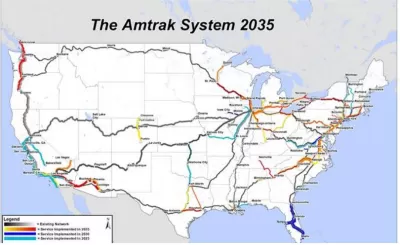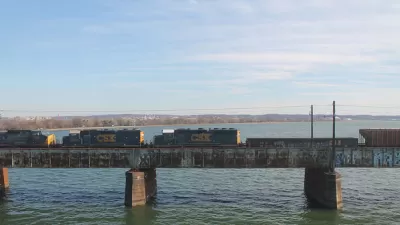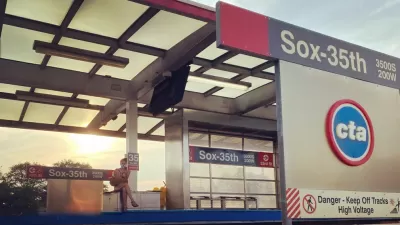Amtrak is presented with the potential for two futures: In one is a $25 billion expansion to update national intercity rail with contemporary patterns of settlement. In the other is fiscal crisis and continued service cuts.

Madalyn Mendoza reports on the diverging potential paths for Amtrak, as exemplified by the example of Texas, where the agency recently reduced Texas Eagle daily service from San Antonio to Chicago to three times a week.
That service reduction was made as Amtrak also makes news for a $25 billion plan to expand service around the country. "Amtrak is also hoping to tap into funds from potential national infrastructure bills such as the INVEST Act, which would provide $28.55 billion for Amtrack over five years," reports Mendoza.
Mendoza relays information presented by Ray Lang, Amtrak’s senior director for national state relations, on Amtrak's expansion plans in September, just a few weeks before the cuts to Texas Eagle service were implemented.
A series of Tweets by Politico reporter Sam Mintz shows the maps of Amtrak's planned expansion maps. Both Mintz and Mendoza suggests that Amtrak would fare well under a Biden presidency, in addition to an expected boon to the Gateway Project connecting New Jersey to New York via the Hudson River.
The Texas Eagle service might not be the last service to get cut as Amtrak deals with the fiscal consequences of the pandemic. As reported in a separate article by Pranshu Verma, Amtrak President and CEO William J. Flynn has been lobbying Congress for $4.9 billion in funding to stave off more cuts (that's $2 billion the rail agency's standard appropriation and $2.8 billion in emergency funding). According to Verma, projected revenue for Amtrak has declined by 53 percent in 2020.
FULL STORY: Amtrak has expansion within the San Antonio-Dallas-Houston triangle 'under review'

Trump Administration Could Effectively End Housing Voucher Program
Federal officials are eyeing major cuts to the Section 8 program that helps millions of low-income households pay rent.

Planetizen Federal Action Tracker
A weekly monitor of how Trump’s orders and actions are impacting planners and planning in America.

The 120 Year Old Tiny Home Villages That Sheltered San Francisco’s Earthquake Refugees
More than a century ago, San Francisco mobilized to house thousands of residents displaced by the 1906 earthquake. Could their strategy offer a model for the present?

Alabama School Forestry Initiative Brings Trees to Schoolyards
Trees can improve physical and mental health for students and commnity members.

NYC Outdoor Dining Could Get a Re-Do
The city council is considering making the al fresco dining program year-round to address cost concerns from small businesses.

HSR Reaches Key Settlement in Northern California City
The state’s high-speed rail authority reached an agreement with Millbrae, a key city on the train’s proposed route to San Francisco.
Urban Design for Planners 1: Software Tools
This six-course series explores essential urban design concepts using open source software and equips planners with the tools they need to participate fully in the urban design process.
Planning for Universal Design
Learn the tools for implementing Universal Design in planning regulations.
Ada County Highway District
Clanton & Associates, Inc.
Jessamine County Fiscal Court
Institute for Housing and Urban Development Studies (IHS)
City of Grandview
Harvard GSD Executive Education
Toledo-Lucas County Plan Commissions
Salt Lake City
NYU Wagner Graduate School of Public Service





























